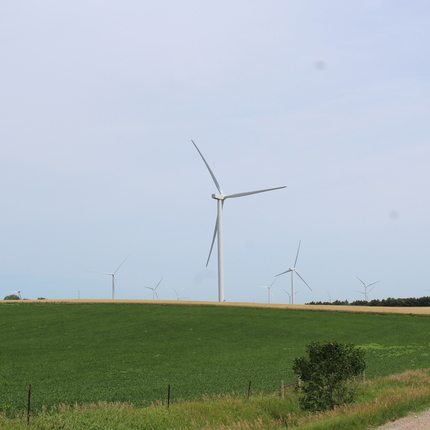By Katie Rock, former staff member. Published in the Des Moines Register, May 11, 2018
Iowa’s future as a leader in renewable energy is on the ballot in 2018. As legislators head home and campaigns gear up for important primary elections, voters should call attention to key policy changes our state will face for our energy future.
Higher blends of ethanol sold year-round can provide opportunities for Iowa’s farmers and for cellulosic ethanol as it grows in volume. Iowa transmission lines are currently expanding to other states, creating more potential for a regional clean energy supply from wind and solar.
And, perhaps most promising, the expansion of solar in Minnesota, Illinois, and other states has been so rapid, federal regulators are moving quickly to update rules around distributed energy resources. As homeowners and businesses add on-site electricity generation and storage, a new set of questions and policies must be addressed.
In the next four years, a number of state and federal incentives that have shaped the energy landscape in Iowa are set to expire. The Renewable Fuel Standard, set in 2005 and expanded in 2007, allowed for mandated increases in biofuels. Biofuel increases were intended to bring commercial cellulosic fuels to scale and on par with starch-based ethanol. While cellulosic fuels are commercially viable, they are still not yet ready to be produced at high volumes. With the phased biofuel increases ending in 2022, what is the future for advanced biofuels derived from biomass?
Also in 2022, state funding sunsets for the Iowa Energy Center, current home of the carefully crafted Iowa Energy Plan. The Iowa Energy Center has helped communities become more energy independent and has championed economic development around clean energy.
We have heard very little discussion on the campaign trail regarding the merits and weaknesses of the Iowa Energy Plan, and the future of the center. Compare that to the gubernatorial campaign in 2006, where funding for the Iowa Power Fund inspired people to vote for then-candidate Chet Culver. People long to be inspired. Actions taken by the state Legislature to dismantle energy efficiency programs leave little for inspiration.
Federal tax credits that have spurred rapid growth of wind energy across the state are on track to phase out by 2019. State policy and existing infrastructure will largely dictate where future growth opportunities lie.
Iowa blazed a trail by developing a Renewable Portfolio Standard in 1983 — the first state to do so. Changes coming in the next four years present a great opportunity to revisit and retool. What should Iowa’s energy future be?
Today marks an opportune time to re-imagine a new vision for renewable energy in Iowa. The state can grow in a number of directions — we could expand our successful solar production tax credit, promote community solar projects, set criteria for energy storage, and create new pathways for financing clean energy upgrades.
A clear vision, combined with strong leadership and smart policy, can make Iowa’s long-standing leadership in renewable energy last for another generation. Voters need to demand fresh ideas and plans from candidates in this election.





